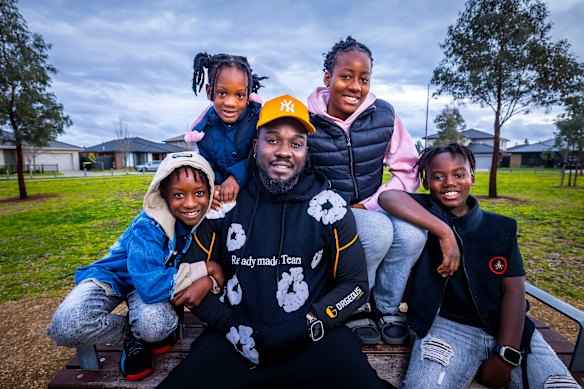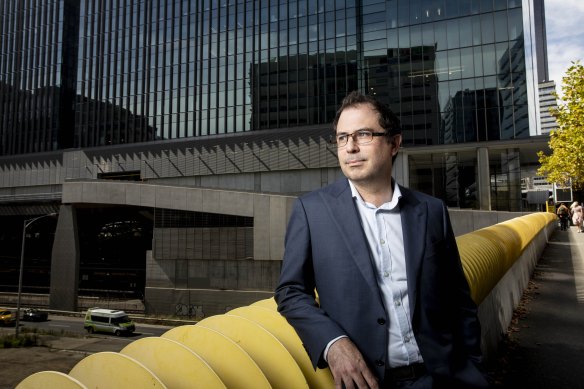By Adam Carey
Melbourne’s fertility rate has plunged more than 8 per cent in the past five years, with rising house prices and stagnant income levels emerging as key reasons people are putting off having more children, new analysis suggests.
Last year, 55,730 babies were born in greater Melbourne, 8.2 per cent less than the 60,690 births recorded in 2019. The city’s population grew by 270,000 people in that five-year period, underlying its heavy reliance on migration to grow.

Ola Ominiyi and his children (from left) Samuel, 10, Marvella, 6, Ashanti, 16, and Abraham, 10, live in Strathtulloh, near Melton.Credit: Wayne Taylor
Melbourne’s fertility rate – the average number of children born in a woman’s lifetime – fell to 1.4 last year, the lowest among major Australian cities, and well below the replacement rate of 2.1 needed to maintain a city’s population without migration.
But the declining fertility rate was not spread evenly across the city.
Melbourne’s newest outer suburbs remain fertile breeding ground for new families, while the inner-city and affluent middle suburbs have become relative baby deserts.
The statistics, based on preliminary analysis of Australian Bureau of Statistics data by KPMG, also show that fertility rates are closely aligned with house sizes in Melbourne. Suburbs with the highest fertility rates typically have houses with three or more bedrooms on average, while less fertile suburbs are dominated by one- and two-bedroom homes.
But there are outliers: a large handful of wealthy suburbs filled with big family-sized homes that are unaffordable to most young families and increasingly filled with empty-nesters.
KPMG Urban Economist Terry Rawnsley said Melbourne’s declining birth rate could be linked to recent high inflation and worsening housing affordability.
“When disposable incomes are growing slowly or shrinking, people will often reduce the number of births,” he said.
The analysis reveals Melbourne contains several affluent suburbs where the average home has more than three bedrooms, but a fertility rate of less than one. These include Glen Waverley, Balwyn, Hawthorn, Northcote and Burwood East.
Melbourne’s inner city – where the housing market is defined by one- and two-bedroom apartments – has the lowest fertility rate of all, with suburbs including the CBD, Southbank, West Melbourne and Carlton sitting at as little as 0.35.
A handful of affordable outer suburbs bucked the trend, exhibiting birth rates well above the citywide average.
Growth corridor suburbs on Melbourne’s fringes, such as Mickleham, Rockbank, Wollert, Cobblebank and Clyde North are among the most fertile in the city. They are also places where a family home with three or four bedrooms can be bought for less than $600,000.
“Those more affordable western and northern growth areas with bigger homes, that’s the place where people are saying, ‘Well, I want two or three kids, and it’s much easier to do that in a three- or four-bedroom home than a two-bedroom apartment’,” Rawnsley said.
Rawnsley said the data underlines Melbourne’s need for more affordable housing, including beyond greenfield estates, arguing there is a strong need for more affordable housing in middle ring suburbs.
“The thing about those locations is they’ve got the existing school network, they’ve got the existing maternal child health, the open space. So government’s not on the hook for providing that, whereas if we rely just on the greenfields, they’ve got to find the cash for the new state school, the new maternal child health, everything on that front.”
Ola Ominiyi and his family of six moved to Strathtulloh – Melbourne’s most fertile suburb, with a birth rate of 2.64 – in 2020.
Keen to buy in Melbourne’s west, the family had hunted around in Sunshine, closer to the CBD, but were priced out, so bought a double-storey house in a new estate in Strathtulloh, an emerging suburb near Melton.

KPMG’s Terry Rawnsley says Terry Rawnsley says Melbourne’s declining birth rate can be linked to high inflation and worsening housing affordability.Credit: Arsineh Houspian
Ominiyi, who works in the disability care sector, was also drawn to Strathtulloh because it is near the future Melton Hospital, which entered the major construction phase this week.
He said the area was family-friendly, and that crime hadn’t been a problem.
“It’s a good place for children. There’s lots of parks around and other children for them to play with,” he said.
David McCloskey, chief executive and chief data scientist at Mimesis Labs, said that while having children was a choice, “for those who want to, it’s a hell of a lot harder”.
Unaffordable housing was prompting more people to live with parents for longer, and for couples to delay living together, he said. Couples typically must also earn two incomes to pay off a mortgage, which also leads them to delay starting a family.
“I would actually say that the structure of what we have now, with the unaffordable housing challenges, and really [being] in a bit of a dog race in employment etcetera is not very family friendly,” McCloskey said.
Start the day with a summary of the day’s most important and interesting stories, analysis and insights. Sign up for our Morning Edition newsletter.